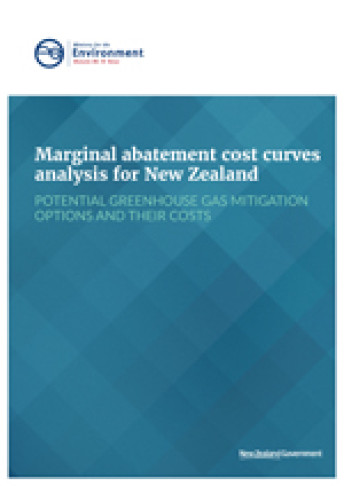This report presents the results of our work to identify a range of possible options to reduce net greenhouse gas emissions in New Zealand, as well as the potential scale and estimated costs of each option.
This report presents the results of our work to identify a range of possible options to reduce net greenhouse gas emissions in New Zealand, as well as the potential scale and estimated costs of each option.
The report provides information that will support submissions to the consultation on the proposed settings within the New Zealand Emissions Trading Scheme.
Further information
Briefing to the Minister for Climate Change
Brief guide to using the MACCs tool [PDF, 342 KB]
MACCs tool spreadsheet [Excel, 10 MB]
Historical data spreadsheet [Excel, 3.8 MB]
Does this show that the government is going to rapidly push the carbon price up?
- No. While the options presented here include those at very high carbon prices well above $100/tonne, the government is not considering allowing NZ ETS prices to rise to that level.
- The report is an assessment of the overall economic costs of different mitigation options and informing us on which are very high cost (and how high) is useful.
- We have proposed setting a trigger price of $50/tonne for the new price controls in the NZ ETS (an effective price cap) for the next five years to 2025.
- What the report does show is that there are plenty of options for New Zealand to reduce its emissions cost-effectively right now, particularly through:
- Greater levels of wind generation
- Energy efficiency
- Greater uptake of electric vehicles.
- The Government is putting in place the supporting policies that will encourage emissions reductions in these areas. Read more about the Government’s proposals for Accelerating renewable energy and energy efficiency at Accelerating renewable energy and energy efficiency [MBIE website].
- More information on the government’s draft Clean Car Discount and Clean Car Standard is available at Clean cars [Ministry of Transport website].
How was the report used to develop the proposed ETS settings?
- The report was used to inform how the provisional emissions budget was set.
- The provisional emissions budget – when compared to the current forecast of net emissions – determines the amount of additional abatement or sequestration needed over the next five years in order to track towards our 2050 target under the Zero Carbon Act.
- The analysis in the report provides a starting point of how much abatement is potentially (or technically) available based on current information and assumptions, and the carbon prices that would make them economic to undertake.
- To estimate total abatement that could be achieved, the speed of uptake of different technologies and approaches also had to be estimated. The report provides these estimates.
- The consultation document Reforming the Emissions Trading Scheme: Proposed settings provides has more detail on how this was done on pages 27-31.
I want to make a submission on the ETS settings and provisional emissions budget – how is this information related?
- This information relates to the provisional emissions budget.
- The report provides estimates of both how much emissions could be reduced by different technologies and approaches, as well as estimates of their overall cost to New Zealand on a dollars-per-tonne-abated basis.
- If you wish to comment on the level of the provisional emissions budget proposed and the amount of emissions reductions necessary to meet it, this report may be useful to you in considering what options are available. Bearing in mind that this analysis estimates only technical potential – realisable potential is influenced by other factors such as local suitability, or capacity constraints that were not able to be included in this analysis.
- You can make a submission at Reforming the New Zealand Emissions Trading Scheme: proposed settings.
